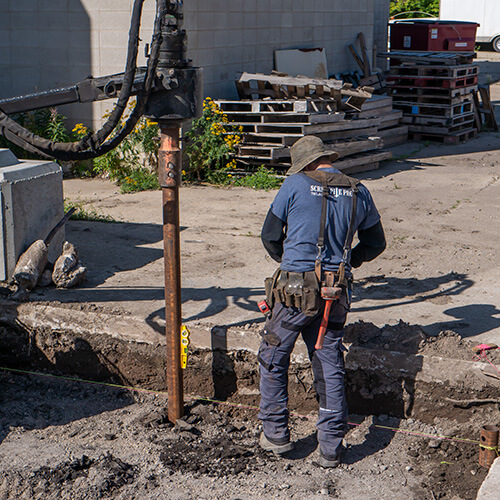What are screw piles & how do they work?
Helical screw piles provided by the Edmonton Screw Pile Pros are a deep ground foundation system used to support many structures that are built in unstable soil conditions. Made out of a steel shaft with a single or multiple helixes (or plates that resemble screw threads) attached to the end. The helix transfers the load from the pile to the ground while the pile shaft transfers the load from the structure to the helix.
How are helical screw piles installed?
In order to install a screw pile into the earth, a hydraulic drive head is used to rotate the pile shaft. While exerting downward pressure on the pile, the helix bites into the soil like the threads on a wood screw. The use of high torque and slow speed ensures the helix turns through the soil without displacing it. If incorrect equipment is used, the soil can be displaced and the helical pile’s load capacity can be compromised. The pile can handle both vertical and horizontal loads since the helixes are made to offer axial and lateral resistance.

Applications
Screw piles are a popular choice for many applications, including building foundations, retaining walls, backyard decks, and many other structures. They can be constructed rapidly and with little disruption to the surrounding region. They can also be reused if necessary and are relatively simple to remove. Screw piles can also be used to resist horizontal loads like wind or seismic stresses because they can be installed at an angle. If you’re ready to have screw piles installed, check out our step by step installation guide to learn more.
How to know how many piles will I need?
The number of screw piles required for a project depends on several factors, including the load requirements, soil conditions, and the size and type of the structure being supported. Here are some steps to help determine how many screw piles you will need:
- Identify the load requirements: The weight of the structure being supported and any additional loads, such as snow, wind, or seismic forces, must be determined in the first stage. You can use this to establish each pile’s necessary load capacity.
- Evaluate the soil conditions: Soil conditions will affect the load-bearing capacity of the screw piles. It is important to have a soil test or geotechnical report that provides information on the soil type, bearing capacity, and any potential challenges or obstacles.
- Choose the size and type of screw pile: The size and type of screw pile required will depend on the load requirements and soil conditions. The number of helixes and their size will affect the load-bearing capacity of the pile.
- Calculate the spacing: The spacing between each screw pile will depend on the load requirements and soil conditions. Generally, screw piles are installed in a grid pattern to evenly distribute the load.
- Consult with a qualified contractor: Finally, it is best to consult with a qualified contractor who has experience with screw pile installation. They can provide a site assessment and help determine the exact number of screw piles required for the project.
How deep do helical piles need to go?
Once a helical pier’s helix goes beyond the frost line (min. 8’), the depth of a helical screw pile is determined by the soil condition. The soil condition must be stable enough to support the load of the structure that is being held by the screw pile foundation in that specific application.
During installation, the torque applied to the pile shaft is monitored. This applied torque indicates the supporting capability that the helix of the pile is being turned through. The minimum applied torque that is required will be calculated and specified by a structural engineer. The engineers provide a document called a foundation design. The foundation design will provide the screw pile installers with a minimum torque specification. If a screw pile’s minimum applied torque is not met, the soil it is in will not be able to support the load of the structure. To correct this, either a pile with a larger helix will be needed or an extension can be added to move the helix deeper into the soil until better soil conditions are found.
Engineered Foundation Design
An engineered foundation design is calculated and provided by a structural engineer. An engineer will determine the loads of the structure being built. The engineer will then calculate the loads that are required to be held by each specific screw pile in each specific pile location as well as their spacing.
When the Edmonton Screw Pile Pros install helical screw piles, the applied installation torque is monitored and recorded. These torque numbers are provided to the structural engineer that designed the foundation. One of the benefits of helical piles vs. concrete footings is the ability to measure a pile’s capacity during installation. This makes it possible for the engineer to verify and sign off on a foundation’s load carrying capacity. This is how the Edmonton Screw Pile Pros can guarantee the longevity, stability, and safety of all the foundations that we install.
